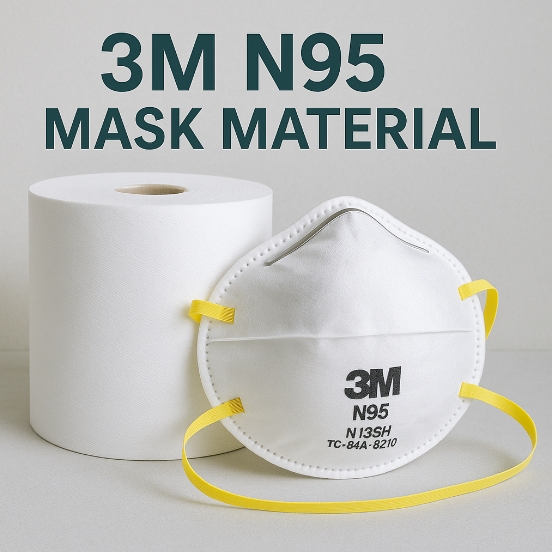For professional buyers sourcing respiratory protection and users relying on 3M N95 masks, understanding the core materials is crucial. What are 3M N95 masks made of? The answer lies in a sophisticated, multi-layered construction primarily utilizing specialized nonwoven fabrics, engineered for superior filtration and comfort. Let’s break down the essential 3M N95 mask material components.

- The Foundation: Spunbond Nonwoven Polypropylene (Facing Layers)
- Material: High-strength polypropylene fibers.
- Process: Fibers are spun and directly bonded (thermally or chemically).
- Role: The outermost and innermost layers provide crucial structure, durability, and comfort against the skin. They repel larger droplets and particles, protect the critical inner filter media, and manage moisture. This robust 3M non woven fabric ensures the mask maintains its shape during use.
- The Heart: Electrostatic Meltblown Nonwoven Fabric (Filtration Media)
- Material: Ultra-fine polypropylene microfibers.
- Process: Molten polymer is extruded through fine nozzles, stretched by hot air into microfibers, and collected randomly on a conveyor, forming a dense, web-like structure. Crucially, it undergoes an electrostatic charging process (corona or triboelectric).
- Role: This is the true powerhouse of the N95 mask material. The dense web physically traps particles (via mechanisms like inertial impaction, interception, and diffusion), while the embedded electrostatic charge attracts and captures even smaller particles (like aerosols and many viruses) that might otherwise pass through. This Meltblown Nonwoven Fabric is responsible for achieving the ≥95% filtration efficiency against 0.3 micron particles required by the NIOSH N95 standard. The specific formulation and density of this layer are key 3M proprietary technologies.
- Additional Components:
- Nose Clip: Typically a malleable metal (like aluminum) strip covered in foam or plastic, ensuring a tight, adjustable seal over the nose bridge – essential for preventing leaks.
- Elastic Headbands: Usually made from synthetic rubber or thermoplastic elastomers (TPE), designed for secure, comfortable fit and extended wear without excessive pressure.
- Foam (Optional): Sometimes found on the inner nose bridge area for enhanced comfort and seal.
- Valve (Optional – e.g., 8210/8511 vs. 8210+/8511+): Made from plastic (like polypropylene) and silicone, it reduces heat and moisture buildup during exhalation for user comfort (note: valves only filter inhaled air, not exhaled breath).
Why 3M’s Material Choices Matter:
- Proprietary Formulations: 3M’s expertise lies not just in using Meltblown Nonwoven Fabric, but in how it’s engineered – fiber size distribution, web density, and especially the specific electrostatic charging method and stability. This directly impacts initial filtration efficiency and how well the charge holds over time (charge retention).
- Layer Synergy: The combination of spunbond support layers protecting the delicate meltblown core is critical for performance and durability. The specific bonding methods between layers also contribute to integrity.
- Rigorous Standards: All materials must meet stringent biocompatibility and safety standards for prolonged skin contact and inhalation safety. Every batch of 3M mask material undergoes rigorous quality control.
Key Takeaways on 3M N95 Mask Material:
- Core Construction: Multiple layers of polypropylene nonwoven fabrics.
- Critical Layer: Electrostatically charged Meltblown Nonwoven Fabric is the essential filtration media enabling ≥95% efficiency.
- Support & Comfort: Spunbond nonwoven polypropylene layers provide structure, durability, and skin comfort.
- Seal & Fit: Metal nose clip and elastic headbands ensure minimal leakage.
- 3M Expertise: Proprietary engineering of the meltblown media and layer integration deliver reliable, certified protection meeting NIOSH N95 standards.
FAQs:
- Is the “3M non woven fabric” special? Yes, while the base materials (polypropylene) are common, 3M’s specific manufacturing processes, quality control, and proprietary treatments for the meltblown layer are key to their consistent high performance and certification.
- Can I wash a 3M N95 mask? No. Washing damages the electrostatic charge in the meltblown layer, severely degrading filtration performance. It is not recommended and voids NIOSH certification for reuse. Follow manufacturer guidance on use and disposal.
- What about other materials like cotton? Genuine, certified 3M N95 respirators do not use cotton or woven fabrics as primary filtration media. Their effectiveness relies on the engineered nonwoven polypropylene layers described.
Understanding the sophisticated blend of nonwoven fabrics, especially the vital role of electrostatically charged Meltblown Nonwoven Fabric, is key to appreciating the science behind reliable 3M N95 respiratory protection. This knowledge empowers procurement decisions and reinforces confidence in the product’s performance for end-users.
Looking for high-quality nonwoven solutions? NW Fabric specializes in premium spunbond and meltblown nonwoven fabrics, the essential materials underpinning effective PPE. Explore our range engineered for performance and reliability. Learn how our materials meet stringent standards.
